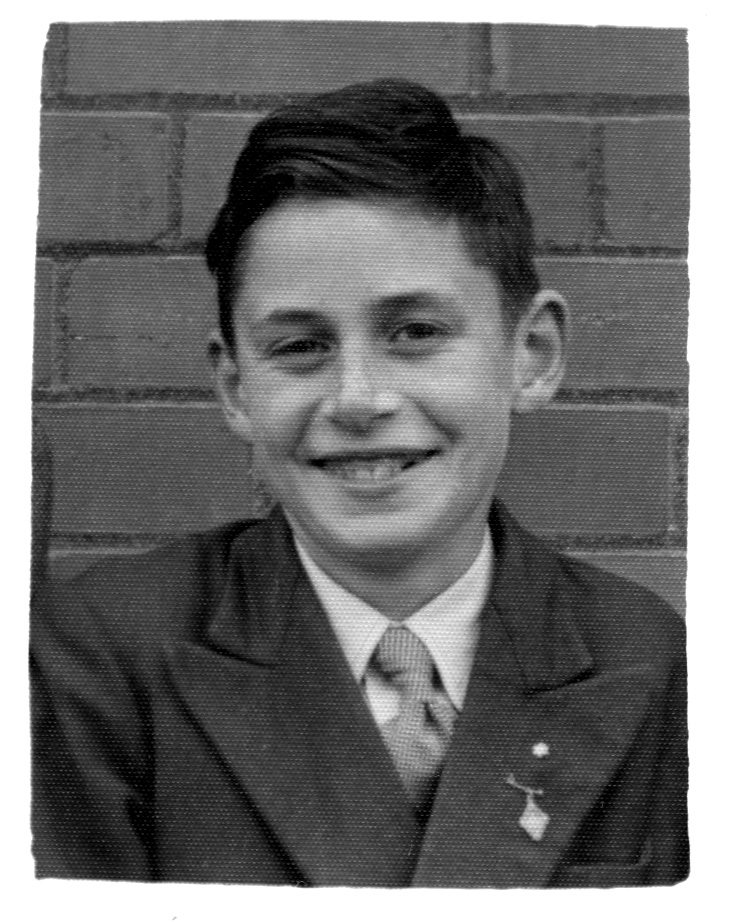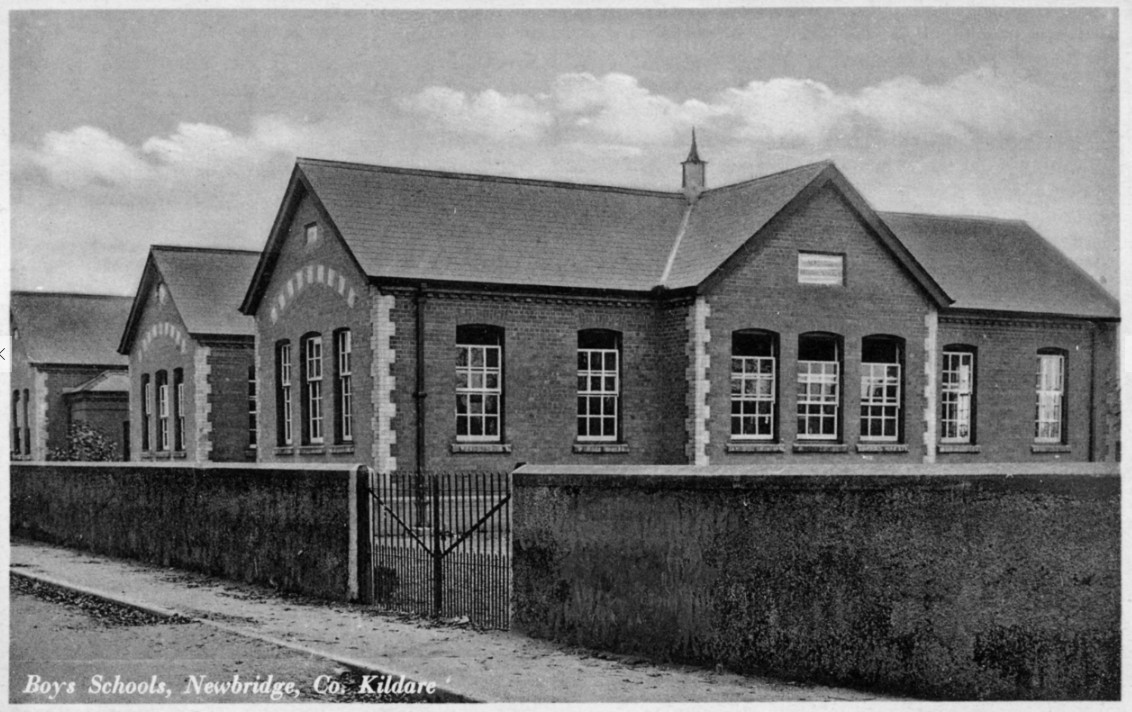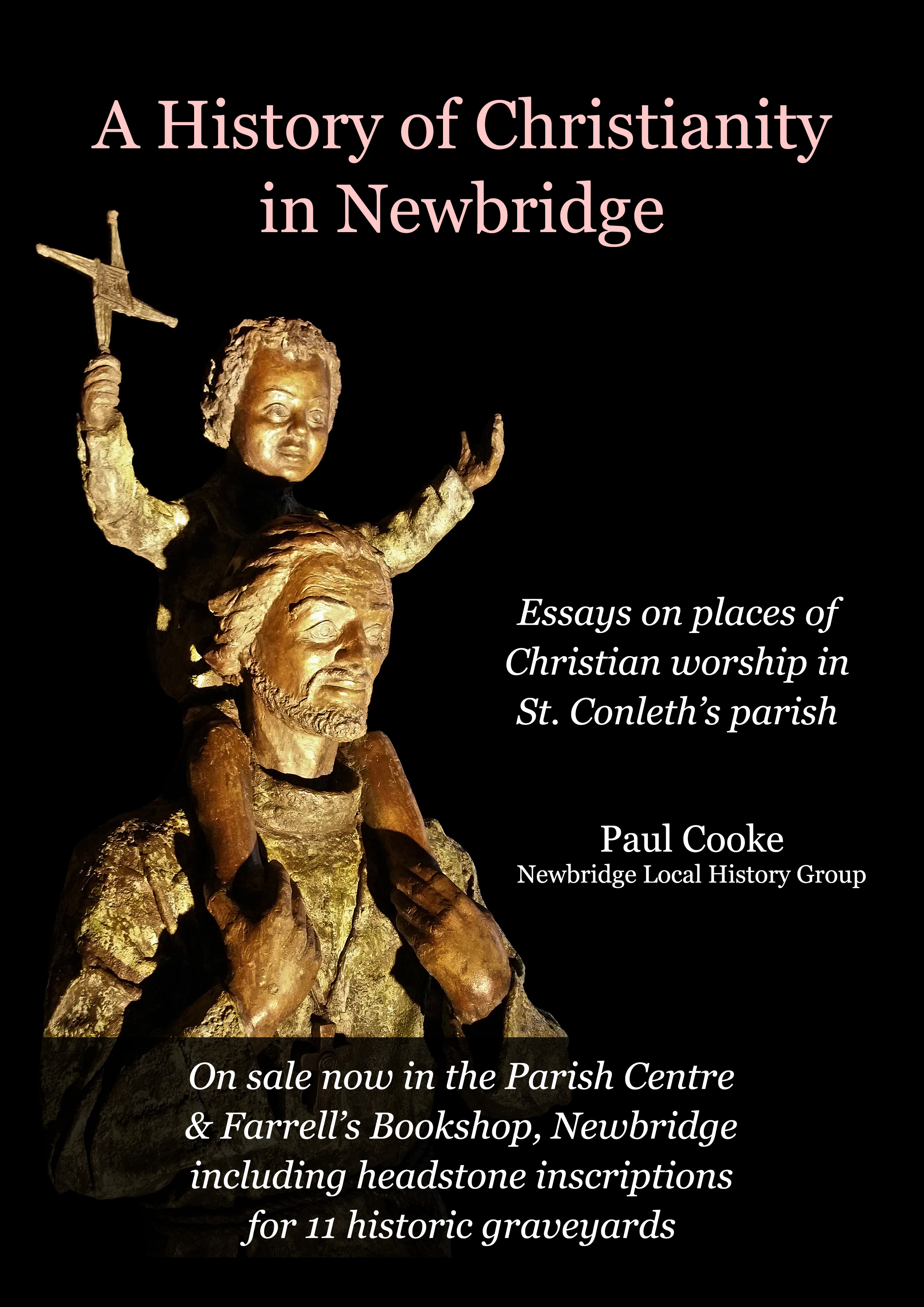Frank Boland: National School with the Patrician Brothers 1951-56.
National School with the Patrician Brothers 1951 ---- 1956
I attended the Boys National School in Newbridge from 1951 until 1956. All my teachers were Patrician Brothers. I was taught by Brothers John, Fidelis, Dominic, Ultan and Michael (Malone). There was only one lay teacher in the school for a while during this period; Sir Blanchfield from Athgarvan,
I first set out in Aug. 1951 on the “long” trek from No. 10 Liffey View in the Barracks up to second class in an old building in Charlotte St. which is now the Parish Centre. The Patrician Bros. occupied two rooms up there for a short period because the school on Chapel Lane was fully occupied and the “new” school, St. Conleth’s and Mary’s, had not yet been built. My walking journey took me through the Barrack Gate out to the Main St. at the Arch Bar and O’Rourke’s grocery and bar. Then I walked up the Main St. past the Odeon Cinema with Dowling’s butcher’s shop and McMahon’s sweet shop and ice-cream parlour on each side. I then turned right into George’s St. between Flanagan’s pub and Warner’s drapery and went on past Dickie White’s bookie’s shop on the right, Anderson’s hackney and undertaking premises, the Masonic Hall on the left and Lucy Halligan’s haulage business on the right. The other buildings on both sides were residential. At the end of George’s St., I turned left onto Eyre St. at Fahy’s jewellery shop on the corner. My walk up Eyre St. to Charlotte St. took me past Heiton’s coal yard, Josie Abbins’s grocery, Sex’s pub and Malone’s butcher’s yard on one side and Kavanagh’s grocery, Higgins’s tailors and Bradley’s printers on the other side. Mention of Malone’s yard reminds me with some horror of once on the way home from school, viewing the slaughter of a sheep through a hole in the sheeting on the gate. Once was enough. There would be “wild” talk from the lookers-on of getting the bladder for a football; but of course that did not materialise.

Second class was located in a large room downstairs while the combined sixth and seventh classes were in an upstairs room. Brother John was our teacher and Brother Michael (Malone), the Principal, took charge upstairs of 6th and 7th classes. The classroom was very large and there was quite a lot of spare space. There were no school desks like we were used to in our previous Infants’ school in the Chapel lane. Our “desks” were large wooden folding tables and wooden folding forms for seats with several pupils to each table. I remember that Brother John was good at drawings on the blackboard with coloured chalk. I particularly remember one drawing of “the flight into Egypt” from the gospel story of the angel telling St. Joseph in a dream “to take Mary and child and flee into Egypt”. His drawing depicted Joseph leading a donkey carrying Mary and the baby Jesus and a piece of string tied to the donkey’s tail. Of course, we enquired about the string only to be informed that it was for the flea. While Brother John was gifted with the chalk drawings, he was also adept at throwing the chalk at any perceived “offenders”. An unusual aspect of our end of daily class activity was the singing of a song titled, “Let him go, let him tarry”. We did not really fully understand the sentiments of the song or the fact that it was a traditional Irish song but, nevertheless, we sang it with gusto. Perhaps our enthusiasm had to do with the fact that it signalled our escape to freedom. I still remember the words. An incident occurred in class during snowy weather which I clearly remember. One of the lads had an “accident” during class and Brother John said that the wet on the floor was the snow from his boots. But another pupil, being very helpful, announced that this was not the case as he had seen it falling.
Our class moved back to St. Conleth’s Boy’s School in the Chapel Lane for third class and onwards. Third, fourth and fifth classes were the three classrooms on the left hand side corridor of the main door of the building marked “Boys”. The school yard and football pitch were on the left hand side of the school further down the Chapel Lane.
Brother Fidelis was our teacher in third class. The only feature that I remember of the room was a scroll hanging on the wall depicting the Vikings’ raids, though it may have been the killing of Brian Boru at the Battle of Clontarf. Brother Fidelis was not well and he died in June of that year. He was fond of plums and would often send Joe Hughes from The Rathfield up the town to get some. Our class was confirmed in May of that year, 1953. Confirmation was only held in the parish every three years then. The bishop was Dr. Keogh and Mr. Paddy Mansfield of Morristown Lattin was the general sponsor. He stood behind every boy with his hand on our shoulder as we were being confirmed. Apparently, he had this “honour” as his family had donated the land for the building of the church. I remember the celebrations afterwards when I attempted and failed to finish a large bottle of Taylor Keith lemonade and subsequently paid the penalty. Dessie O’Brien of The Barracks was my desk mate in third class and he always attempted to make me laugh at the singing of “My Land” (Thomas Davis) which was sung to the tune of The Boys of Wexford. Everytime that there was a mention of land, eg., fresh, fair, rich, dear, rare etc., he would sing “boland” and I was under pressure not to laugh and be subject to censure or worse from Brother Fidelis. There was a funny incident involving Dinny O’Brien from The Rathfield during a catechism (religious instruction) class. It was amusing for us but not so for Dinny. The Brother (not Brother Fidelis) gave a talk on St.Therese, popularly known as The Little Flower, and he asked Vinny for her popular name. Dinny suggested Daisy and he “suffered” the consequences. Mention of the catechism, which was a book of questions and answers, reminds me of the rote learning of the answers and our lack of understanding of what we were learning. Whilst we could sing off the answers, we often hadn’t a clue what they meant. I still particularly remember the following one. “Actual sin is the sin which we ourselves commit by any wilful thought, word, deed or omission contrary to the law of God”. It was many years later when it dawned on me that the word that I had been singing was actually “contrary” and I only then realised its meaning. Well, we probably qualified for many of these sins but certainly did not realise it from our study of the catechism in primary school. An unusual event that year was the arrival of some boys, Seamus and Paddy Aspell, Billy Schwer, Paddy Humphries and Sean Farrell, on transfer from Kilcullen School.
Fourth class was under the control of Brother Dominic. One day he showed me the name on a letter and it was addressed to Bro. Dominic Lyons. He asked me if I knew that I was living with the Lyons. “Life with the Lyons” was a popular BBC radio programme at the time. Brother Dominic was also in charge of the school football team. I remember him coaching Tommie Brennan, a very good footballer and The Barrack’s captain, to follow through with his boot when kicking out the ball. We were all amazed that the ball went further each time he did as instructed. George Crolly from Clownings was my desk mate in this class and I remember an incident between him and Brother Dominic. It happened when Brother Dominic went to give George a bit of a punch on the arm (he would give you the knuckle on your arm muscle). George held up his hand in protection, but was holding his pen and you can guess the outcome. Well, suffice to say that George’s plea of self defence did not succeed. Brother Dominic was invalided later in life (I think with MS) and lived in the Cheshire Home in Shillelagh, Co. Wicklow.
Brother Ultan was my teacher in fifth class. He was the “farmer” in the monastery and looked after the cows and their milking. The cows used the two fields behind the old monastery, around where the current monastery is now situated. I do remember him handing out some punishment to a couple of boys. It was in this class that I remember a visit from the Diocesan Examiner. His function was to examine the pupils’ knowledge of the catechism and report back to the bishop. Fr. Kaye was his name and he was accompanied by the P.P., Doctor (later Monsignor) Miller and one of the curates. There was a question about absolution for a reserved sin. I think that it was the sin of perjury and only the bishop or a nominated parish priest was empowered to give absolution for it. Fr. Kaye asked me if he could give absolution for this sin. I replied that I did not know as I didn’t know if he was a parish priest or not. Well the other two priests fell about the place laughing. He admitted to not being a parish priest. I think that he later became P.P. in Edenderry.
Sixth class was with Brother Michael (Malone), the school principal. He was an excellent teacher and a gentleman and he made a great impression on me. He was a proud Kilkenny man and often mentioned his home place of Piltown. Being a Kilkenny man, he had an interest in hurling and I remember him talking about the hurling prowess of Diamond Hayden, a noted fullback for Kilkenny. By coincidence, I had seen Diamond playing as my late father was a Tipperary man and he often brought me to hurling matches. Brother Michael used to say that he would be going to see them play, if he was allowed. I did not understand this issue about being “allowed” and why he would have to get permission from anyone. He was a pipe smoker and a peppermint sweet lover. Tony Dunne, whose mother had a sweet shop in Lower Eyre St., kept him supplied in Ritchie’s mints. Cycling was a regular past-time for him and he would often be seen around the roads on his bike. He was a fine baritone singer and had a special interest in music. I remember that he was in charge of the boys’ choir that did carol singing around the town for the St. Vincent De Paul Society. The carol singers were each given a handful of bullseye sweets when going out singing and I remember them sticking to the lining of my pockets. Not too sure that the pockets were clean, but anyway, I survived. Sixth class was the final year in primary school and the state exam at that stage was the Primary Certificate. The subjects were English, Irish and arithmetic (maths). Mental arithmetic was a part of the maths exam. Only the answer was written down. No need for calculators in those days. Everyone passed the exam. The daily attendance figures for each class in the school were recorded on a small blackboard hanging on the wall. The total figure was always around 300 pupils. Hard to credit nowadays that there were only 300 boys approximately in total attending school in Newbridge back then. Brother Michael was transferred in the last few days of the school year in 1956 and we had the new Principal, Brother Lazerian, for a little while. This was a shock to the system as Brother Michael was up there on a pedestal as far as I was concerned. Any replacement was always going to be a bit of a let down.

The following pupils’ names, which were written in Irish, are taken from the roll book for 4th class from 1953: Paddy Dowling, Seamus Morning, John Joe Geraghty, George Crolly, Patsy Reck, Tony Lumsden, Joe Doherty, Joe Coffey, Dermot McMorrow, Paddy Tidd, Donie Bowdren, Paddy Farrell, Con Doherty, Ollie Meade, Hughie Garrett, Gerry O’ Connor, Tony Mooney, Mick Doyle, Joe France, Tommie Brennan, Mick Halford, Mick Kennedy, Paddy Hensey, Frankie Boland, Tom Rochford, John Hayes, Tony Dunne, Kevin Keogh, Tony White, Will Murphy, Fergus Brennan, Noel McDonagh, Niall Conlan, Paddy Kenny, Michael Cooney and Tom Kennedy. The following additional names from this class also appear on the roll book for 6th class in 1955: Michael Booth, Frankie Rooney, Con Bradley, Stan Deegan, Michael O’ Connor, Donal Galvin, Noel Galvin, Connie Moore, Seamus Aspell, Paddy Aspell and Paddy Humphries.

